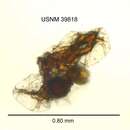en
names in breadcrumbs


Asplanchna brightwellii are a species of rotifer from the genus Asplanchna. They are known to inhabit eutrophic water.[2] The sac-like freshwater rotifier is known to eat cladocerans, protozoans, and other rotifers.[2][3] A. brightwelli are relatively large for rotifiers, transparent and ovoviviparous which makes the species ideal for morphological studies.[4]
Asplanchna brightwellii are a species of rotifer from the genus Asplanchna. They are known to inhabit eutrophic water. The sac-like freshwater rotifier is known to eat cladocerans, protozoans, and other rotifers. A. brightwelli are relatively large for rotifiers, transparent and ovoviviparous which makes the species ideal for morphological studies.